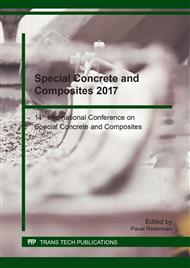[1]
C. Shi, P.V. Krivenko, D. Roy, Alkali-activated Cements and Concretes, Taylor & Francis, Oxon, UK, (2006).
DOI: 10.4324/9780203390672
Google Scholar
[2]
J. L. Provis, J.S. J van Deventer, Alkali Activated Materials, RILEM, Springer, (2014).
Google Scholar
[3]
F. Puertas, T. Amat, A. Fernandez-Jimenez, T. Vazquez, Mechanical and durable behaviour of alkaline cement mortars reinforced with polypropylene fibres, Cem. Concr. Res. 33 (2003) 2031-(2036).
DOI: 10.1016/s0008-8846(03)00222-9
Google Scholar
[4]
C. D. Johnston, Fiber-reinforced Cements and Concretes, Taylor & Francis, London, (2010).
Google Scholar
[5]
M. Şahmaran, I. Ö. Yaman, Hybrid fiber reinforced self-compacting concrete with a high volume coarse fly ash, Constr. Build. Mater. 21 (2007) 150-156.
DOI: 10.1016/j.conbuildmat.2005.06.032
Google Scholar
[6]
F. Bencardino, L. Rizzuti, G. Spadea, R.N. Swamy, Experimental evaluation of fiber reinforced concrete fracture properties. Composites Part B: Eng. 41 (2010) 17-24.
DOI: 10.1016/j.compositesb.2009.09.002
Google Scholar
[7]
B. Han, S. Ding, X. Yu, Intrinsic self-sensing concrete and structures: A review, Measurement, 59 (2015) 110-128.
DOI: 10.1016/j.measurement.2014.09.048
Google Scholar
[8]
P. J. Tumidajski, P. Xie, M. Arnott, J. J. Beaudoin, Overlay current in a conductive concrete snow melting system, Cem. Concr. Res. 33 (2003) 1807-1809.
DOI: 10.1016/s0008-8846(03)00198-4
Google Scholar
[9]
H. Guan, S. Liu, Y. Duan, J. Cheng, Cement based electromagnetic shielding and absorbing building materials, Cem. Concr. Comp. 28 (2006) 468-474.
DOI: 10.1016/j.cemconcomp.2005.12.004
Google Scholar
[10]
B. Han, X. Yu, E. Kwon, A self-sensing carbon nanotube/cement composite for traffic monitoring, Nanotechnology 20 (2009) 445501-445505.
DOI: 10.1088/0957-4484/20/44/445501
Google Scholar
[11]
M. Saafi, K. Andrew, P. L. Tang, D. McGhon, S. Taylor, M. Rahman, S. Yang, X. Zhou, Multifunctional properties of carbon nanotube/fly ash geopolymeric nanocomposites Constr. Build. Mater. 49 (2013) 46-55.
DOI: 10.1016/j.conbuildmat.2013.08.007
Google Scholar
[12]
J. L. Vilaplana, F. J. Baeza, O. Galao, E. Zornoza, P. Garcés, Self-Sensing Properties of Alkali Activated Blast Furnace Slag (BFS) Composites Reinforced with Carbon Fibers, Materials 6 (2013) 4776-4786.
DOI: 10.3390/ma6104776
Google Scholar


